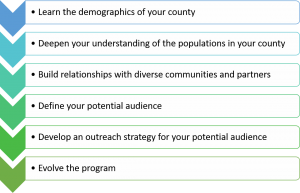
Inclusion, diversity and equity guides our educational programming and our relationships in the workplace. We recognize and respond to the challenges and opportunities that impact our work now and in the future. In the context of changing demographics in Wisconsin, inclusion, diversity and equity is required in our many initiatives to promote non-discrimination and drive innovation and excellence.
Our commitment to expanding access to underrepresented and under-served audiences along with intentional all reasonable efforts toward those categorically protected from discrimination in the Civil Rights Act of 1964 enables us to develop needs-based programming. When all voices are heard and we are more responsive we add value and relevancy to what we do and extend the Wisconsin Idea. What follows are steps to inclusive program planning to expand access to under-served, underrepresented and categorically protected audiences.
PROGRAM PLANNING
- Learn the demographics of your county

- Gather and analyze population data
- Determine who lives in the community
- What do you know about them?
- Deepen your understanding of the populations of your county
- Look beyond their attributes; also look at their circumstances
- Consider what the needs, interests, challenges and/or opportunities are of diverse, under-served and underrepresented audiences
- Find out what meaningful change looks like for diverse audiences
- Consider power and privilege dynamics in your local area
- Seek input from advisory groups, collaborators and partners
- Engage in professional development and other activities that serve to increase your awareness of your own and other cultures, worldviews and learning styles
- Establish and build relationships with diverse communities and partners
- Collaborate in designing educational, organizational, evaluative approaches that reflect what matters most to diverse and underrepresented audiences
- Gather input from communities, advisory groups, and other organizations and partners to help define program goals
- Solicit feedback on how culturally relevant the program content and mode of delivery is to the diverse audiences you are attempting to reach
- Define your potential audience
- Look at census data for the county in which you are doing programming and identify the percentages of individuals that are protected by the Civil Rights Act of 1964
- Determine individuals/groups reflective of all demographics that would have interest and benefit from participation in the program
- Be sure it is inclusive of women, and individuals with race other than white, and individuals with Hispanic/Latino ethnicity and other under-served and underrepresented program audiences.
- Develop an outreach strategy for your potential audience
- Target or focus efforts toward specific communities based on program goals
- Determine potential barriers to reaching diverse audiences
- Determine the practices and principles you will apply to overcome barriers to reaching diverse audiences
- All reasonable efforts include media, personal invitations, letters, culturally relevant brochures, and personal visits to encourage participation
- Network with organizations and agencies that help you reach underrepresented and under-served audiences
- Evolve the program
- Identification of expected and realized outcomes
- How did your actual audience compare with your potential audience?
- What new partnerships were developed?
- Have you started marketing your programs in any new locations or with new strategies?
- What other efforts did you make to reach diverse, under-served, underrepresented audiences?
- What extent did protected and under-served audiences benefit from my program?
- What worked well?
- What will I do differently next time?
- Identification of expected and realized outcomes
REFLECTION QUESTIONS:
- What are the experiences that have most impacted who you are today?
- How do you work to invite diverse perspectives into your work?
- Can you identify any biases that you might have? What strategies can you identify to mitigate the impact your biases might have on your work?
- What is one step you can take tomorrow to learn about a population in your community that don’t know a lot about? What is another step you can take in the next month? In the next year?



